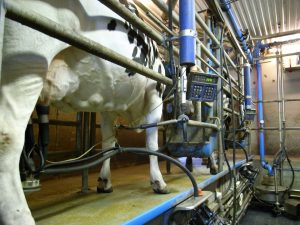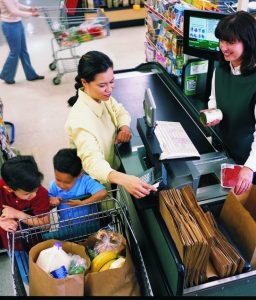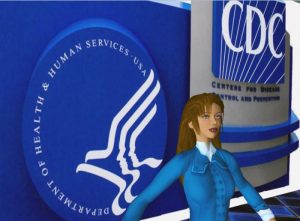Unit 1 – Food Safety
1.5 Safe Food Systems
What is a Food System?
Today, very few people grow and process their own food. Most of the foods we eat are purchased from a grocery store or at a restaurant. These foods go through a network of suppliers known as the “food system.” (Food chains deal how lower level plants are eaten by larger ones. Food systems deal with the humans who process foods.) The system begins with farmers followed by related operations, including food processing, wholesale and distribution, retail, industry technology, marketing, and should end with recycling.

The milk industry is an excellent example. The system follows this pattern:
- Farmers raise livestock.
- Milking facilities extract the product.
- Processing companies pasteurize milk and package it.
- Shipping companies deliver the product to stores.
- Grocery stores stock and sell the products.
- Advertising agencies tout the product to consumers.
- Consumers uneaten foods and recycle the packaging.
- Recycling facilities sort the containers for reuse.
The public also plays a role in the food system. If people choose not to eat a particular food, the need for that food decreases. If food processors continue producing it, they lose business and money. Therefore consumer demand dictates food availability. Based on US data, close to 20,000 new food products are introduced each year. The top three groups include beverages, snack foods, and sauces/seasonings, three groups high in added sugars, sodium, and fat, yet low in the micronutrients. These added sugars, sodium, and fat contribute to diet-related health problems. However, it’s important to note that only about ten percent of new food products are successful.
| Table 1.1 Number and type of new products introduced in the United States from 2015 to 2020 [1] | ||||||
|---|---|---|---|---|---|---|
| Product type | 2015 | 2016 | 2017 | 2018 | 2019 | 2020 |
| New products | 17,156 | 21,466 | 21,060 | 20,354 | 20,064 | 20,341 |
| Beverages | 22.3 | 18.6 | 18.2 | 19.0 | 17.1 | 16.5 |
| Snacks | 14.3 | 14.9 | 14.3 | 12.3 | 14.8 | 13.2 |
| Sauces and seasonings | 8.9 | 8.9 | 9.8 | 10.7 | 8.7 | 12.2 |
| Bakery foods | 11.6 | 12.6 | 11.4 | 10.2 | 10.7 | 10.7 |
| Dairy | 7.2 | 7.2 | 7.3 | 7.0 | 7.9 | 8.4 |
| Processed fish, meat, and egg products | 5.8 | 6.3 | 7.9 | 7.9 | 7.3 | 8.3 |
| Candy and gum | 7.2 | 8.7 | 7.1 | 6.1 | 9.3 | 5.3 |
| Meals and entrees | 4.9 | 5.5 | 5.6 | 7.0 | 6.5 | 5.2 |
| Fruit and vegetables | 2.6 | 3.2 | 3.9 | 4.6 | 3.2 | |
Table 1.2 includes the claims included on the new products. Toping the list are Kosher foods followed by those claiming to have low allergen levels and gluten free.
| Table 1.2 Number of new product introductions in the top 10 product claim categories for 2015–2020 [2] | ||||||
|---|---|---|---|---|---|---|
| Tag or claim* | 2015 | 2016 | 2017 | 2018 | 2019 | 2020 |
| Kosher | 7,427 | 8,997 | 8,797 | 8,543 | 8,474 | 8,385 |
| Low-allergen or no/reduced allergen | 4,924 | 6,588 | 6,130 | 6,010 | 6,678 | 6,373 |
| Gluten free | 4,542 | 6,150 | 5,743 | 5,578 | 6,157 | 5,876 |
| No additives/preservatives | 3,478 | 4,602 | 4,810 | 4,994 | 4,909 | 4,685 |
| GMO-free | 2,689 | 3,735 | 4,054 | 4,330 | 4,738 | 4,557 |
| Ethical—environmentally friendly packaging | 4,244 | 5,059 | 4,498 | 4,520 | 4,249 | 3,999 |
| Ethical—recycling | 4,036 | 4,834 | 4,277 | 4,317 | 3,999 | 3,701 |
| Social media | 2,872 | 4,006 | 3,696 | 3,341 | 3,774 | 3,454 |
| Organic | 2,314 | 3,005 | 3,091 | 2,928 | 2,884 | 3,302 |
| Free from added/artificial preservatives | — | 2,637 | 2,710 | 2,779 | 3,041 | 2,668 |
Before reading more about the various regulatory agencies, watch the short video that describes the natural food chain.
VIDEO: Understanding Food Systems for Healthier Diets. By CGIAR (formerly the Consultative Group for International Agricultural Research). October 17, 2019. (2:40 minutes)
How Food Systems Are Regulated
Several food regulatory agencies work to protect the consumer and ensure the safety of our food. In the United States, regulation of food and drugs started in the late nineteenth century when state and local governments began to enact regulatory policies. In 1906, Congress passed the Pure Food and Drugs Act, which led to the creation of the US Food and Drug Administration (FDA). It was the first food law passed in the United States. Today, a number of agencies are in charge of monitoring how food is produced, processed, and packaged.[3].
The Food and Drug Administration (FDA)
FDA focuses on enforcing food laws. In addition, they have the authority over food ingredients, pharmaceutical drugs, and food label claims. Sometimes FDA must require a manufacturer to issue a food recall for products that are contaminated and remove them from the market to protect public health. For example, in 2011, contaminated peanut butter led to the recall of thousands of jars of peanut butter.[4] In most instances, food companies will recall their affected products when they discover a problem.
Many consumers have concerns about safety practices during the production and distribution of foods. The concern is especially critical given recent outbreaks of foodborne illnesses at restaurants such as Chipotle Mexican Grill. Between 2015 and 2018, 1,100 people became ill after eating at a Chipolte restaurant. According to an FDA report:
From approximately 2015 to 2018, Chipotle faced at least five food safety incidents at various restaurants around the country, which stemmed primarily from store-level employees’ failure to follow Chipotle’s food safety policies and procedures, including the policy requiring the exclusion of restaurant employees who were sick or recently had been sick, as well as a failure by restaurant employees to hold food at appropriate temperatures to prevent and control for the growth of foodborne pathogens. [5]
The culprit pathogen was E Coli in the 2015 outbreaks and Clostridium perfringens in 2018. Both bacteria proliferate in foods held at inappropriate temperatures. In 2020, Chipotle agreed to pay a $25 million fine to resolve charges stemming from the outbreaks.
The United States Department of Agriculture (USDA)

USDA develops and executes federal policy on food and farming. This agency supports farmers and ranchers, protects natural resources, promotes trade, and seeks to end hunger. USDA oversees the School Nutrition Program, Supplemental Food Program for Women, Infants, and Children (WIC), and the Special Supplemental Nutrition Program (SNAP). They also promote food safety and oversee the regulation of meat, poultry, and processed egg products. (Note: FDA regulates all other foods, including eggs still in the shell.) The Dietary Guidelines for Americans and the MyPlate food guidance resources are under USDA’s direction.
The Environmental Protection Agency (EPA)
EPA works mainly in protecting the environment. Founded in 1970, EPA oversees water quality and the use of pesticides. EPA approves pesticides and other chemicals used in farming and limits how much residue can remain on food. They also analyze food for pesticide and other chemical residues. Processing methods can either reduce or concentrate pesticide residue in foods. Therefore, the Food Quality Protection Act, passed in 1996, requires manufacturers to show that food pesticide levels are safe.
The Centers for Disease Control and Prevention (CDC)

In addition to monitoring chronic and communicable disease, the CDC tracks foodborne disease outbreaks. An outbreak s defined as more cases of a disease in time or place than expected. If two or more cases have the same laboratory diagnosis, the outbreak is considered “laboratory-confirmed.” Because many of the illnesses from eating spoiled foods only last a few hours, most people do not report the condition, and few have the condition confirmed in a laboratory. Therefore, foodborne illness outbreaks are often underreported.
VIDEO: “Foodborne Disease Outbreaks” Centers for Disease Control and Prevention. (2:20 minutes)
The Food and Agriculture OrganIzation (FAO) of the United Nations
Globally, FAO is the arm of the United Nations that provides guidance and regulation for all countries in the world. In addition to providing food to underdeveloped countries, they assist each country in developing its food-based dietary guidelines. Working with the World Health Organization (WHO), FAO developed and maintains the Codex Alimentarius. The Codex is the international food standards and policies used for global food trade safety, ethics, and fairness.
VIDEO: “Codex and Science” by FAO and WHO. Describe how international food codes are based on scientific data. (2:15 minutes)
Review Questions
- USDA Economic Research. "New Foods" May 27, 2021 https://www.ers.usda.gov/topics/food-markets-prices/processing-marketing/new-products/ ↵
- USDA Economic Research. "New Foods" May 27, 2021 https://www.ers.usda.gov/topics/food-markets-prices/processing-marketing/new-products/ ↵
- History of Food and Drug Regulation in the United States. EH.Net Encyclopedia. http://eh.net/?s=History+of+Food+and+Drug+Regulation+in+the+United+States. Published February 4, 2010. Accessed January 28, 2018. ↵
- FDA 101: Product Recalls—From First Alert to Effectiveness Checks. US Food and Drug Administration. http://www.fda.gov/ForConsumers/ConsumerUpdates/ucm049070.htm. Updated September 9, 2011. Accessed January 18, 2018. ↵
- US Food and Drug Administration. “Chipotle Mexican Grill Agrees to Pay $25 Million Fine to Resolve Charges Stemming from More Than 1,100 Cases of Foodborne Illness.” April 21, 2020. https://www.fda.gov/inspections-compliance-enforcement-and-criminal-investigations/press-releases/chipotle-mexican-grill-agrees-pay-25-million-fine-resolve-charges-stemming-more-1100-cases-foodborne ↵
Food production, processing, distribution, consumption and
disposal of foods. Also known as food chain.
Vitamin and minerals that are need in "microscopic" amounts. Young women need only 18 mg of iron and 75 mg of vitamin C Protein is a macronutrient because women need about 50 to 60 grams of it each day.
Food that complies with the strict dietary standards of traditional Jewish law.
A protein found in wheat, rye, and oats. People who have celiac disease must avoid gluten-containing foods.
Legislation which regulates the production, trade and handling of food. Basically, it covers the regulation of food control, food safety and relevant aspects of food trade.
A product recall is a request from a manufacturer to return a product after the discovery of safety issues or product defects that might endanger the consumer or put the maker/seller at risk of legal action
Either accidental or intentional addition of a biological substance, chemical, or foreign object that makes food un-safe for human consumption.
Short for the bacteria Escherichia coli. Many of the species are harmless but some cause foodborne illnesses. The E. coli O157: H7 bacteria strain that had contaminated hamburger patties sold at area Jack in the Box restaurants in 1993 was responsible for several deaths.
Bacteria that is one of the most common causes of foodborne illness (food poisoning). CDC estimates these bacteria cause nearly 1 million illnesses in the United States every year.
A substance used for destroying insects or other organisms harmful to cultivated plants or to animals. The subtypes of pesticides include insecticides, herbicides, rodenticides, and fungicides.
Something that persists for a long time or constantly recurring.
Centers for Disease Control and Prevention
When two or more people get the same illness from the same contaminated food or drink.

